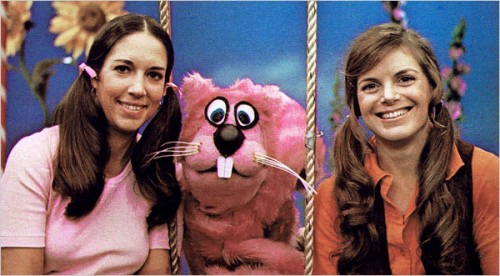This guest post by Hayley Krischer appears as part of our theme week on Children’s Television.
Kids of the 1970s weren’t exactly background noise as they were in the 1950s or worse, used as child labor as they were in the early 1900s, but if you were under 10 between 1971-1978, you probably knew the feeling of getting tossed around in the back seat of a car with no seatbelts. We rolled around in dirty piles of leaves left out on the street. Girls across the US regularly burned their knuckles on the incandescent light bulb used to “cook” brownies in the iconic Easy-Bake Oven. Movies for kids revolved around drunk baseball coaches who cursed you out if you didn’t hit a home run. (Though that movie, with a female pitcher of an all boys baseball team, happened to be my favorite.) We drank potentially lethal doses of Coke and Pop Rocks to see if our stomach would explode. (Urban legend warned the kid from the “Hey Mikey, he likes it,” Life cereal commercial died from the combination.)
The one safe place it seemed for kids of the 1970s was, believe it or not, planted in front of the television. There in the comfort of your den (which morphed into the “family room” by the 1980s), the 70s were at its most educational with Sesame Street, the most influential with Fat Albert, the most feminist with Free to Be You and Me, and the most creative with The Muppet Show. Schoolhouse Rock taught us about interjections. Sesame Street taught us that it was OK to have an imaginary friend (Snuffleupagus used to be Big Birds’s pretend buddy before they allowed everyone to see him).
And squeezed in between all of this creative genius was a sweet little interlude broadcasted on a local New York station headed by Carole Demas and Paula Janis called The Magic Garden. With their soft voices and pigtails Paula and Carole had a purpose: they created a serene little oasis while sitting on swings and singing, calling kids to “come and see our garden grow.” In The Magic Garden, there was a garden of make-believe where the “magic tree grows lollypop sticks.” Paula picked on her guitar and Carole encouraged you to stamp your feet or clap your hands on the “pop” during “Pop Goes the Weasel” without sounding like a droning fire alarm. Watching an episode of The Magic Garden was like going to a music class—the women pushed kids to sing faster and faster with the speed of the music, harmonizing and smiling, their easy melody a break of sorts to all of the outside noise.
And like a lot of children’s television shows in the 70s—Romper Room, Sesame Street, The Electric Company, The New Zoo Revue and the king of make-believe, Fred Rogers —The Magic Garden was live-action. Carole and Paula had skits—my favorite being the Story Box: it was a beat up trunk box, really. But when it was opened, a world of imagination appeared, giving me the tools and encouragement to allow my mind to dream. Carole and Paula would pull out props and costumes. Other special regulars included a patch of daisies called the Chuckle Patch where the ladies would pull out jokes on little cards. The flowers would giggle after each joke.
Now it’s hard to watch any children’s television without comparing it to The Magic Garden—though Yo Gabba Gabba, with its sweet songs and not-so-pushy life lessons (“Nice and easy, nice and slow. But sometimes I like to move around and dance, dance, dance!”) feels like a good successor to those shows of the 70s. There’s an element of kitsch delivered with some emotional acknowledgement about how children deal with real life situations.
Watching it as an adult, I see how limited a production The Magic Garden was, but that was part of its appeal, I think. The tree was fake. The Chuckle Patch wasn’t made of real flowers. But as a child, set production isn’t important. The Magic Garden’s focus was all about Carole and Paula—they drove the show forward with their sunny momentum. Other shows during that time had fuzzy and cuddly adult leaders, sure, but they were mostly men. There was Mr. Hooper on Sesame Street, Fred Rogers, Gordon (who is still played by Roscoe Orman) on Sesame Street and Captain Kangaroo. Yes, there was the female host on Romper Room, but she was as rotating host.
Paula and Carole might as well have been my mother’s friends, or neighbors who happened to play guitar and have super cool ideas who smiled all the time and sang in lovely harmony. They came into my house daily with their tales from their Magic Garden. And I adored them.
Hayley Krischer is a regular writer for Salon about the intersection of feminism and pop culture. She co-writes the feminist parenting blog Femamom and you can also find her on Twitter or on her Tumblr where she’s currently obsessing over Orange Is The New Black.

1 thought on “‘The Magic Garden’: Female Leaders In Children’s Television”
Comments are closed.